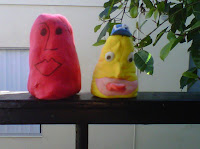I've learned a thing or two about children's behavior since then and one thing I have learned is never try to reach a child when they are in the midst of a temper tantrum. It's similar to getting my dog's attention when she sees a squirrel...it's just not going to happen. The point is, once a child is in a state of emotional overload, not much is going to distract them let alone getting them to talk about what they are feeling. What you can do though, is let them know you are there for them, hold them, tell them they must be feeling really bad right now proceed to gently rock them. Once they have calmed down, you can then move to the next step which is getting them to verbalize what they are feeling. I recommend giving the names of feelings to them such as, are you feeling mad, sad, happy, frustrated? Children, depending on their age, can't always identify the feeling on their own. Another idea is to have a "feeling" chart in your house. Many times children can look at a facial expression of a feeling and can identify how they are feeling that way. When there is the time, I ask children to create a picture of how they are feeling. I ask them to pick a color, shape and size of their feeling. I would recommend always having markers or crayons on hand and paper. I like to help children identify when they are reaching their so to speak breaking point. They begin to recognize how anger, for instance, they are and can take steps to calm themselves down. They can count, take deep breaths, jump on one foot, do push-ups or take out the coloring supplies. To help children express what they are feeling, here are a few tips:
- Talk openly in your family about feelings
- All feelings are ok...it's how you express them
- Encourage children to use their words not their fists to express feelings
- Help by suggesting a few feelings they might be feeling
- Have a feeling chart in your home
- Share how you are feeling
- Be a positive example, i.e., do you use bad words; do you yell and scream? do you hit?
- children learn by observing and if you do the above...they will.
- Last but not least....STAY CALM!
